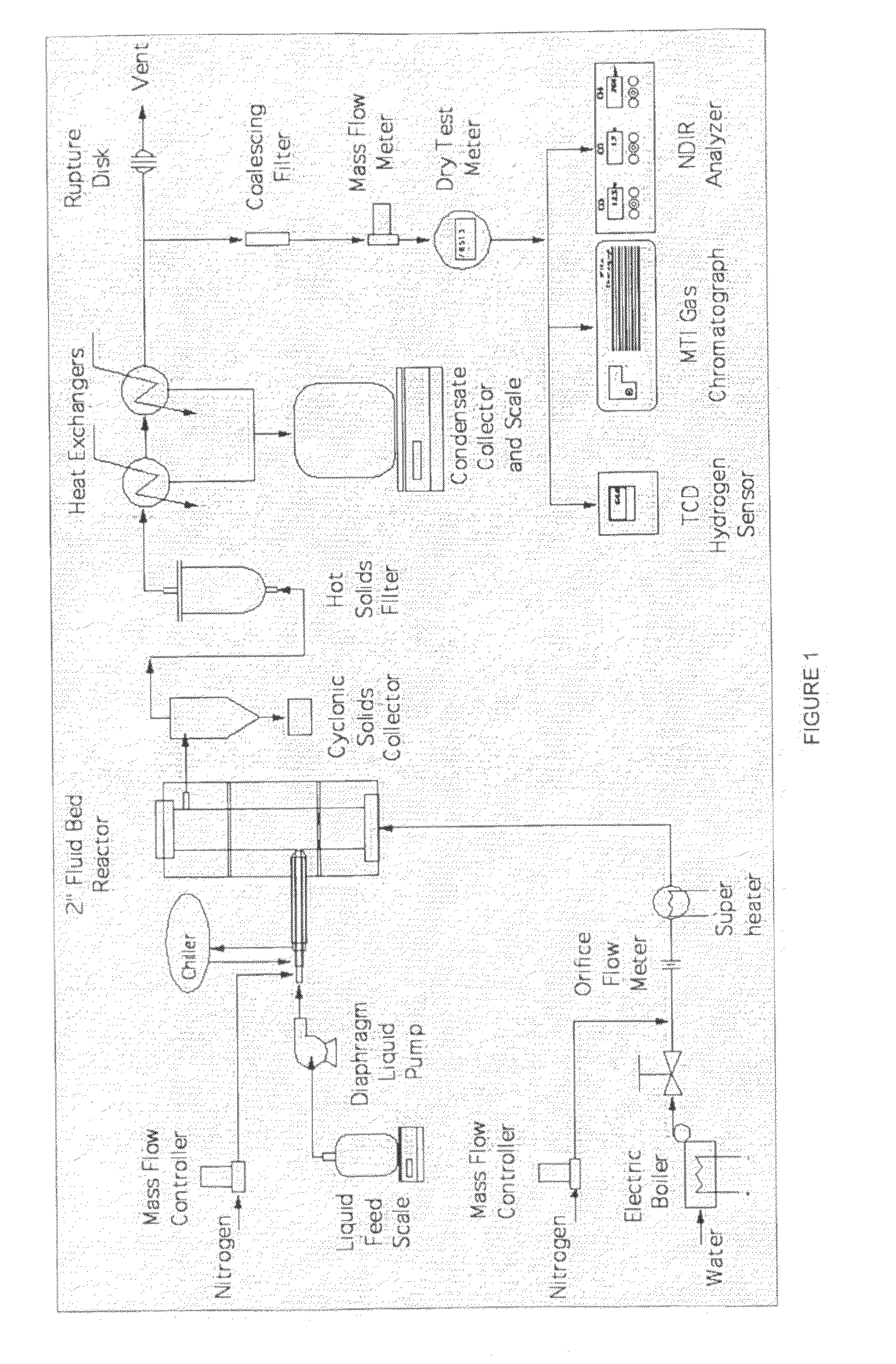Attrition Resistant Fluidizable Reforming Catalyst
a technology of fluidizable reforming catalyst and attrition resistance, which is applied in the direction of catalyst activation/preparation, metal/metal-oxide/metal-hydroxide catalyst, etc., can solve the problems of inability to use a packed bed system, inability to contain the reactor by ordinary means, and readily break down by attrition, so as to improve the resistance to attrition loss
- Summary
- Abstract
- Description
- Claims
- Application Information
AI Technical Summary
Benefits of technology
Problems solved by technology
Method used
Image
Examples
example 1
[0100]Catalyst (Cat.1) is prepared by sequential incipient wetness impregnation of the dry support material followed by drying and calcination of the impregnated material to decompose the metal precursor salt and form the metal oxide. Two aqueous solutions were prepared for this purpose. A Ni salt solution was prepared by combining 240.1 grams of Ni(NO3)2.6H2O salt with 150.09 grams of deionized water (DI). A Mg salt solution was prepared separately by combining 104.41 grams of Mg(NO3)2.6H2O salt with 100.52 grams of DI water. 374.99 grams of support material (D) with a loss-on-ignition (LOI) value of 1.1% by weight was placed in a rotating drum contactor.
[0101]The first of two incipient wetness impregnations of the solid was accomplished by adding 55.07 grams of the Mg salt solution, drop wise, to the tumbling solids in the rotating drum apparatus. The moist solids were then dried and calcined, in air, in an electric muffle furnace. The temperature program consisted in ramping the ...
example 2
[0104]Catalyst (Cat.2) was prepared by multiple and sequential impregnations of the solids in a similar manner as (Cat.1) in example 1. The support material (I) was used in this case. Three successive additions of Mg salt solution were followed by two successive additions of Ni salt solution. Each solution addition was separated by drying and calcinations of the moist solids as described in Example 1 (five complete cycles). Based on dry basis weight differences, the final composition of (Cat.2) was approximately 3.25% w MgO and 4.12% w NiO with respect to the virgin support.
[0105]This catalyst (Cat.2) was tested for attrition resistance and catalytic activity as reported in TABLE.1 and TABLE.3.
TABLE 3ReactantCO2 / COH2 / CH4TarCatalystFeedH2 Yield[mole[moleCrackingIdentityStream[%]ratio]ratio][%]WaterExtractedPyro. OilJ883.727.1NACat. 1830.724.6NACat. 2552.154.7NACat. 9521.884.4NAWholePyro. OilJ94762.5NACat. 1988481NACat. 2691591.2NATrapGreaseJ87431.7NACat. 1880360.8NATarH2 / CH4CO2 / COH2 / ...
example 3
[0106]Catalyst (Cat.9) was prepared using 586.45 grams of support material (I) with an LOI of 0.35% w, a surface area of 1.0 m2 / g, and an incipient wetness of 0.16 ml / g. All the metal salts solutions were combined into one single solution containing the required amounts of each metal. The solution volume is adjusted to the required incipient wetness volume for the mass of support material used. The (Cat.9) formulation is made with one impregnation of the solids followed by drying and calcinations.
[0107]Three stock solutions were prepared to yield a) a Ni salt solution containing the equivalent of 0.218 grams NiO per gram of solution; b) a Mg salt solution containing the equivalent of 0.082 grams of MgO per gram of solution; c) a K salt solution containing the equivalent 0.155 grams of K2O per gram of solution. All solutions were prepared from the nitrate salts. The mixed salt solution is obtained by combining 6.79 grams of the Ni solution with 5.82 grams of Mg solution, 1.97 grams o...
PUM
| Property | Measurement | Unit |
|---|---|---|
| temperature | aaaaa | aaaaa |
| pressure | aaaaa | aaaaa |
| temperature | aaaaa | aaaaa |
Abstract
Description
Claims
Application Information
 Login to View More
Login to View More - R&D
- Intellectual Property
- Life Sciences
- Materials
- Tech Scout
- Unparalleled Data Quality
- Higher Quality Content
- 60% Fewer Hallucinations
Browse by: Latest US Patents, China's latest patents, Technical Efficacy Thesaurus, Application Domain, Technology Topic, Popular Technical Reports.
© 2025 PatSnap. All rights reserved.Legal|Privacy policy|Modern Slavery Act Transparency Statement|Sitemap|About US| Contact US: help@patsnap.com

